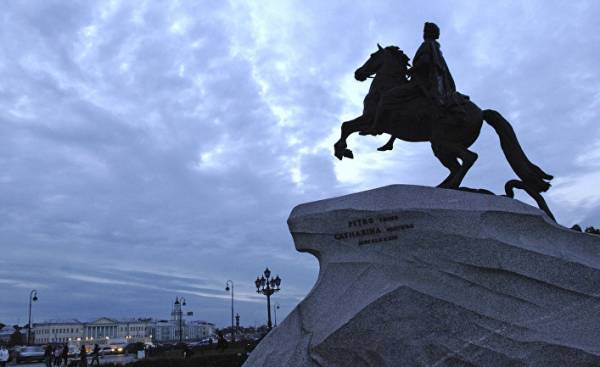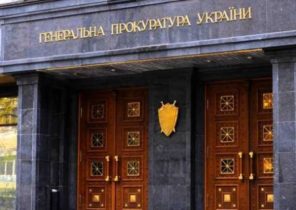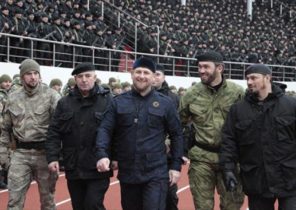
On Nevsky Prospekt for several days now sways the whole sea of red flags. “Bread, give us bread” shout to the frosty air hundreds of thousands of people, disappointed, hungry and tired of war. They seem so small against the towering luxurious boulevards of St. Petersburg palaces.
Every day they are becoming more strike large enterprises, robbing the bakery, more soldiers side with protesters. The protest quickly spread throughout the town and goes into a revolt, which eventually leads to the abdication of the Russian Tsar.
So it was during the February revolution, the event that forever changed the course of history, for it prepared the way for the communism. Although the February revolution, if you look at it today, was the March revolution.
But then we had the Julian calendar, which lags behind the current by 13 days. So in March this year, the February revolution is 100 years, and the city in which there has been this unprecedented revolution of world historical significance, nothing in this regard is not planning.
For what’s in gorgeous St. Petersburg 2017 there will be a large celebration, we have to thank the current Russian rulers in Moscow: the February revolution means a radical upheaval, but it is something that does not Vladimir Putin’s delight. Still it is in respect of the jubilee year used only while the theme of “reconciliation.” No specific guidance the President gave.
St. Petersburg relies on the decadence of the tsarist time
No matter how great were then, social revolutions, historical framing, and today remains the same as in 1917. Many parts of St. Petersburg look like in tsarist times.
The historic city center with more than two thousand buildings in pastel colours and countless Imperial monuments is a UNESCO cultural heritage site. From the name “Leningrad”, which the city received in 1924, it was abandoned in 1991, and what little is left of the St. Petersburg Soviet architecture, is lost between the monuments from the era of the monarchy.
In the city again are proud of the heritage of the Romanovs and willingly rely on the decadence of the tsarist time. For example, in the one-of-Saint-Petersburg “Caviar bar” which sells annually no less 150 kilograms of rare delicacy.
Bar is part of the “Belmond Grand Hotel Europe”, the oldest luxury hotels, mirrors the history of the city. Stayed in this hotel celebrity from Dostoyevsky to Tchaikovsky. The last Tsar, Nicholas II, who willingly met with diplomats.
Today in a five star hotel those who can afford it, approximately 40% of guests are Russians rich. Although quite regularly here looks a distant descendant of the Romanovs, however, has long been not all guests respond to the style of the hotel. It is not equivalent replacement of that brilliant society which before the revolution were filled with apartments and restaurants. “The oligarchs — it’s not the aristocrats,” says with some regret in his voice responsible for PR Irina Khlopova. “With the revolution we have lost many traditions, a way of life.”
The city relies on Peter the Great
Despite this, the city is trying to remind a feasible amount of time, namely, relying on Peter the Great. As the founder of the city he is in Saint-Petersburg is present literally everywhere.
For example, the “bronze horseman” stands as a monument and symbol of the city on Senate square. But you can find also different people in period costumes depicting Peter, on Palace square and about built in elegant style”, zuckerberger” the Church of the Resurrection, where they are photographed with tourists.
Some of them are waiting for tourists even before the “Aurora” is the battlecruiser, a volley of which in 1917 the Bolsheviks was the signal for the storming of the Winter Palace. Came in February to power the Provisional government was overthrown in the summer of 1918 the Bolsheviks eventually killed the Royal family.
 © RIA Novosti, Alexey Danichev | go to fotobanka “Aurora” at the Petrogradskaya embankment in St. Petersburg
© RIA Novosti, Alexey Danichev | go to fotobanka “Aurora” at the Petrogradskaya embankment in St. Petersburg
Today the ship stands as a Museum between sky-blue magnificent building of the Navy and grey former KGB building. On Board show the film “October”, filmed in 1928, and shows the capture of the Imperial residence.
During filming, the Palace suffered more than the rather unentertaining the capture of the real revolutionaries. Peter the Great, Catherine the Great, various Alexandra — all the king’s monuments survived the revolution.
Of the churches made swimming pools and ice rinks
Saint Petersburg was able to maintain its Royal architecture thanks to the fact that Moscow is already six months after the October revolution was declared the capital. One Soviet building in the historic center of St. Petersburg. It is a Higher school of technology and design.
And yet the Soviet time has not passed in vain for is laced with canals “Venice of the East”. Of the churches made swimming pools and skating rinks, palaces slowly fell into decay. “Grand Hotel Europe”, built in 1875, the year of the revolution was first turned into a shelter for homeless families, then became the orphan’s home, and finally during the siege by the German Wehrmacht during the second world war was converted into a hospital.
Meanwhile, the hotel shines again in its old brilliance: for example, there are antique furnishings, the apartments of the Romanovs or Art-Nouveau-Restaurant “L’europe”, which is famous for the fact that they serve the world’s beef Stroganoff, prepared according to original recipe — a descendant of the old Stroganov, who lived in the manor house just around the corner supposedly gave the recipe to the chef.
Most of the ceremonial buildings in the historic center of St. Petersburg was restored to the 300th anniversary of the city in 2003. The most impressive example is the Winter Palace, the former before the revolution, the main residence of the Royal family.
In a luxurious building in the Baroque style are hidden together with the Museum the largest in the world treasures: gold walls, white marble and also collected by Catherine the great works from Rembrandt to da Vinci.
The Palace is so great that the Bolsheviks on the night of 25 October 1917 had spent the last hour looking for the then ruling provisional government. When arrested, the White hall was then stopped clock: still arrows show ten minutes of the third.
The RAID of Soviet nostalgia in “Grand Hotel Europe”
On the Vyborg side of the city, on the contrary, around the Finland station, where in April 1917, Lenin arrived from exile, the streets and squares are still named after Communists. Despite the ensuing civil war and “red terror” that cost the lives of millions of people.
Metro station on the red line, which was opened 50 years, decorated with sculptures of Lenin, hammer and sickle. And in the Moscow area is gloomy “House of Soviets”, one of the few monuments of the Stalin era, before which is the world’s largest statue of Lenin. She almost nobody pays attention, winter kids skate around the monument.
It is in the “Caviar bar” in “Grand Hotel Europe” find a sort of plaque Soviet nostalgia: there’s a popular adhesive depression pressed caviar, which ordinary citizens in the 15th century ate as readily as ordinary Soviet comrades. “We offer it for sentimental reasons,” — said the expert on vodka and caviar Alexander Dimitriev. “Many guests still willing to remember the taste of the Soviet time.”
Cell Russian “window to the West”
But it was the same with the Soviet legacy of St. Petersburg. So, the Museum of the great socialist October revolution was renamed the Museum of political history. In an old Villa, which the Bolsheviks were occupied in 1917, a old study of Lenin.
Located opposite the Peter and Paul fortress, the cell is the Russian “window to the West” that Peter the Great had dreamed all his life and why he built St. Petersburg. The fortress stands as an embodiment of diversity in the history — in a fortress prison in the Trubetskoy Bastion, for example, sitting in conclusion, Lenin’s brother, Alexander, before him as a terrorist was hanged during the reign of Alexander the Third.
Also, Leon Trotsky was sitting under cold arches, and then, after the revolution, there were aristocrats and counterrevolutionaries. About this here although and remember, but much is symbolic that the dungeon in the castle Church, which in 1998 were buried the remains of the last Royal family. Thus Nicholas II, 80 years after his assassination, deliberately went back — to St. Petersburg and in the public consciousness.
Church tower of the Church is, incidentally, the tallest building in the city. Even after the end of the Soviet era, it was decided not to push the Royal legacy in the shadow of modern skyscrapers.







